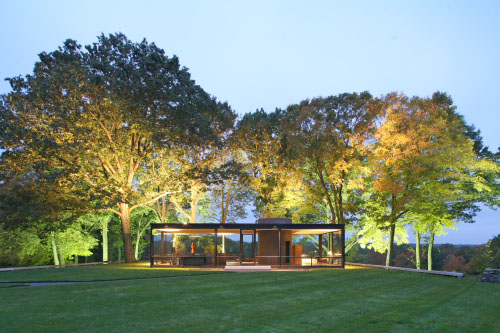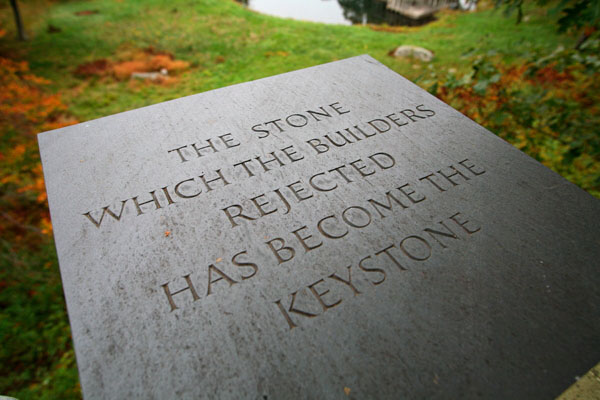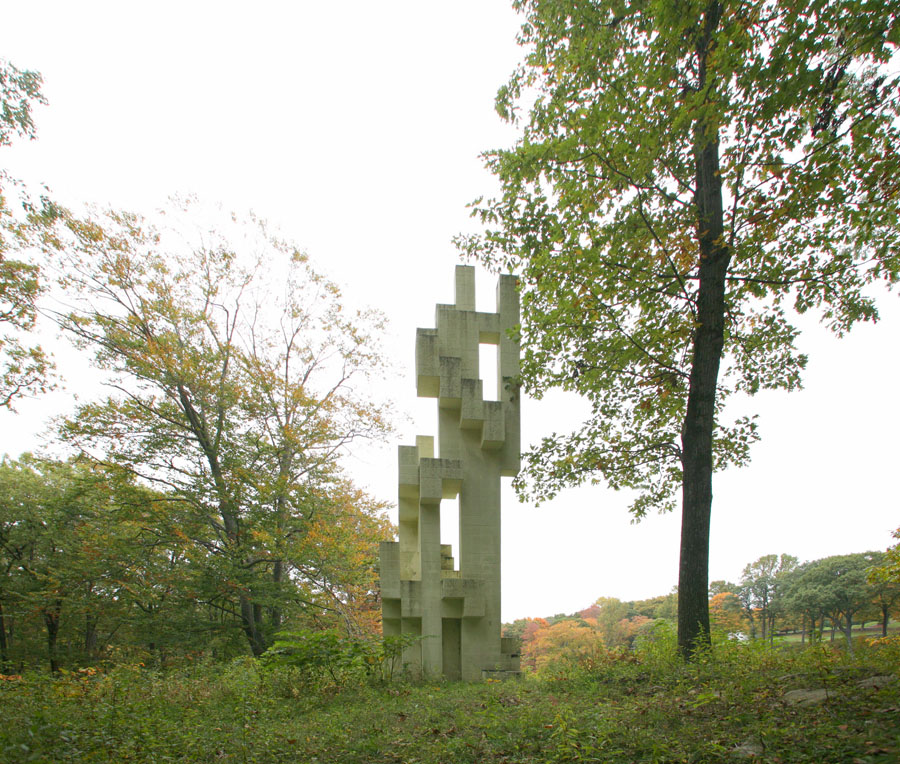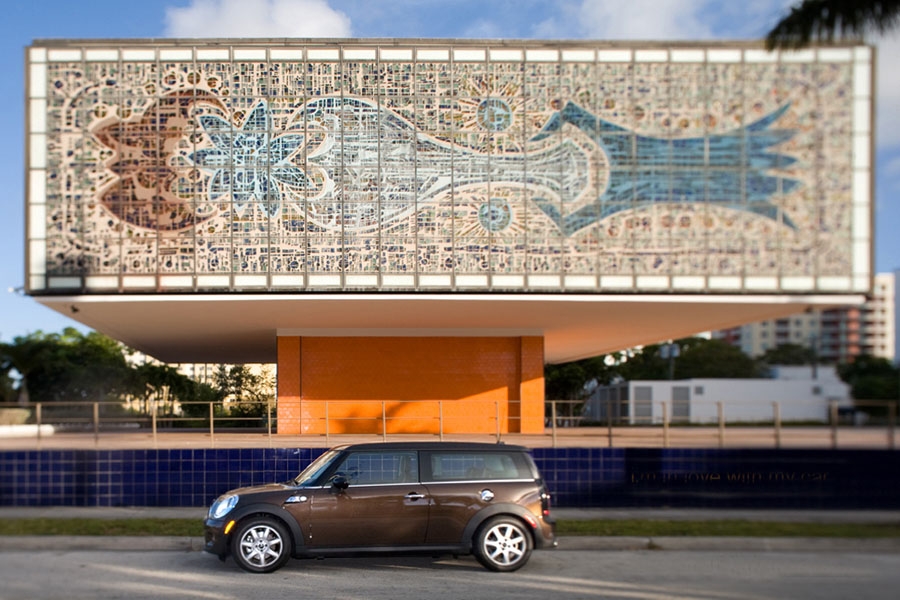In September 2011, publisher Rizzoli New York released The Glass House, a photo tour of Philip Johnson’s famous estate. The book includes text by Philip Johnson himself and by architecture critic Paul Goldberger and is the official Glass House book of The National Trust for Historic Preservation. Robin Hill’s photo “Glass House Dawn” was selected to appear on the book’s cover.
Below is the first of a three-part installment wherein Robin Hill shares his experience of photographing the Glass House estate.
A handful of iconic houses have reached the public imagination, and the Glass House is among the finest. In this transparent pavilion, surrounded by nature, Philip Johnson designed an architectural gem of quiet depth and epic simplicity. Its power arises from the Earth and exerts itself into a natural auditorium that can suffuse the visitor with a sense of grateful contemplation. It is a chapel in a cathedral of nature. One could be tempted into thinking that the Glass House is just a brown rectangular box with see-through walls, but to follow this line of thinking is to miss the point, because its simplicity hides a raw architectural sophistication that transcends an ordinary interpretation of space, providing the visitor with a unique opportunity to experience nature and architecture as a continuous whole.
 Image copyright Robin Hill ©
Image copyright Robin Hill ©

My first visit to the Glass House was in the fall of 2006. However, my experiences of Philip Johnson's buildings previous to this had been somewhat contradictory. On the one hand I had loathed the AT&T Building for its post-modernist faux grandeur, but on the other hand I had witnessed an urgent sensitivity in the architect's hands at the John F. Kennedy Memorial in Dallas. So I was in a mood of uncertainty when I was hired to photograph the Glass House. Was the place worthy of all the adventurous architectural commentary? Could it possibly live up to all the expectations? Given the fact that it has been photographed by all the greats, including Ezra Stoller and Julius Shulman, would I be able to find something that I could call my own? I shouldn't have worried. The place invites many different interpretations. The Glass House owns its iconic status like Clark Gable owns "Gone with the Wind," like Bruce Springsteen owns "Born to Run," and, yes, like David Bowie owns "Thru These Architect's Eyes." The architect's educated hands are everywhere. It breathes Architecture, with a capital “A.” The glass walls integrate the architecture into the landscape and the landscape returns this favor by integrating itself into the architecture. The pavilion is very much part of its location; in the same way as one cannot imagine Stonehenge being anywhere else except on its geomantic nodal point on the Salisbury Plain of England, one cannot perceive a better, more artful location for Johnson's own Glass House, perched on a New England outcrop overlooking a lake.
Whilst pondering the undulating hills of the Glass House property, I began to wonder about the debt owed to Mies Van Der Rohe for this exquisite masterpiece. The Glass House is not an original work of architecture. Johnson had already seen Mies's plans for Farnsworth House, and the two houses share much the same geometry and philosophy of construction. Yet they are profoundly different. One (the Farnsworth) floats; the other clings to the Earth. One is white, the other dark brown. One is next to a river, the other overlooks a lake. One is a singular piece of architecture; the other is the first in a series of calculated structures that interweave over a whole estate. One was birthed into existence by a romance, the other by an architect who always knew that his best client was himself. Johnson is clearly the understudy. When there's a bright beacon of real genius in the room, the best one can do is get out of the way and be inspired. Johnson did just that and was deeply inspired by his master, and the greatest compliment he could give him was the Glass House. The Glass House is different enough from Farnsworth House for it to be labeled Philip Johnson 1949, but one would be tempted to put in parentheses "inspired by an idea of Mies Van Der Rohe."
I am up before the crack of dawn. It is 4:20 AM and I am staying in New Canaan at the Maples Inn. A taxi cab arrives, and into the pitch darkness we go. In the spirit of my Boy Scout days, I have been on a mission of "being prepared," and I have arranged for the lights (designed by lighting pioneer Richard Kelly) of the Glass House to be left on… and sure enough, as we pull into the driveway with deer scattering before our headlights, I see that my request has been honored. The taxi arcs around Donald Judd's circular sculpture and tears off into the night. I am consumed in silence. I am alone. It is a perfect solitude, tranquility personified. There are the beginnings of pre-dawn light; a slight mauve tint starts to fill the lower horizon. My senses are heightened. My tripod is steady and my Canon is armed.
I realize that I have never seen the Glass House photographed from behind the swimming pool. I have a natural and almost naive love for reflections, and I think that lying flat on my belly with the camera just an inch above the water will create something compelling. The trick, then, is to support the camera during a long exposure. Technical terms race through my left brain and artistic concerns run through my right brain and happily they meet somewhere in the middle of my armed Canon. Pre-dawn light is now at a happy interstice with dawn light: on the lower horizon mauve has moved to purple, and farther up the sky has turned from its deep inky black to a nebulous quarter light. The shutter releases. In this moment I am both observer and participant in the passing light show. There is no distinction between the vast Architecture of Nature and the little Architecture of man. In such a place there is no distinction. Breathing together in their own crucible, they are one.
I am now in a state of heightened awareness. Part of me wants to sit and meditate and just take it all in. Another part has a job to do. I have many juxtapositions to explore; the light is changing quickly now and soon sunrise will be upon me, offering up entirely new vistas, and a different palette will come into play. Richard Kelly's exemplary lighting is really starting to glow. In fact, all three of his famous lighting concepts – "focal glow," "ambient luminescence," and "play of brilliants" – seem to be coalescing into one beatific show of light. I am now placed fairly and squarely in front of the Glass House. I am a few steps in front of the Brick House with a direct perpendicular view of my subject. The light has moved on, as is its nature, and the sky has faded to a pale blue, but the trees lined up behind the Glass House are underlit by Kelly's lighting, and the colors of the fall saturate the scene with greens, browns, reds, and yellows. Better not mess this up! The air is cool. The shutter releases again and the mood is captured.

As dawn moves onto early morning, I realize that today will be cloud covered. No shafts of sunlight will issue from a glowing sunrise. I love this kind of day. The colors are muted, and nature is painterly. The whole scene is reminiscent of the famous Nicolas Poussin painting, "The Burial of Phocion," which hangs inside the Glass House. I start to move on from the Glass House itself and explore the other structures that dot the landscape. Each one of them is perfectly placed in a way that is eerily similar to an 18th century British stately home landscape with all its abundant follies. Down by the lake is the Lincoln Kirstein Tower, a sculpture that invites personal adventure, with its risk-taking staircase that lacks a hand rail. Atop the summit is a suitable engraving: "The stone which the builders rejected has become the keystone.” It’s a great voyage up this sculpture. One feels a notion of being on the razor's edge, of being deeply aware of each step of ascent. One's steps are noticeably steady, and balance is the order of the day. The summit calls for a pause.

I can see from here the rectilinear shape of the Glass House, in what seems like a stark composition against the bulbous, overflowing landscape. The house, however, is not incongruent with its surroundings. It seems to possess an aura of mellifluous transcendence. It appears that there are no boundaries between the outside and the inside, between the manmade and the natural, between the architect and the landscape. One might think that a slab of modernist glass contained between bronze pillars would be anathema to the landscape, but in fact the very counterpoint is true. This is not Frank Lloyd Wright's "Falling Water," but it does fit beautifully into its chosen location. A descent of the Lincoln Kirstein Tower is now undertaken or, rather, negotiated. Each step is measured, corrected, singular. The void of space surrounding me is anchored by my feet. I am suspended in a mental tennis match between tackling Johnson's staircase and taking in the view. Another pause is in order. The staircase spirals around the sculpture, and new vistas open up as one descends. One step down brings the lake into view; another couple of steps reveals a New England forest burning with color.
The bottom at last! I feel like I have undergone some kind of test, an ordeal, and that survival has brought a sense of achievement. Yes! I have achieved the ascent and descent of the Lincoln Kirstein Tower without fracture. I have pondered the Glass House from an alternate viewpoint, read the inscription, and returned to Earth a wiser person. I can't say if Johnson had in mind the proliferation of wisdom when he designed this piece, but my own experience was cultivated and my awareness expanded through my interaction with it. I have noticed with fresh eyes a beautiful connection between architecture and Nature, between literature and design, between risk and reward.

This is the first of a three-part installment wherein Robin Hill shares his experience of photographing the Glass House estate. Stay tuned for parts two and three. In the meantime please visit robinhill.net for a closer look at his photography. All content in this article is copyrighted by Robin Hill ©.

Robin Hill
Originally from Nottingham, England, Robin Hill is an architectural photographer based in Miami Beach. Over the last 25 years his photography has been published in many of the world's leading design publications including Architectural Record, Landscape Architecture Magazine, Garden Design and Vanity Fair. His photographs of Frank Lloyd Wright's Florida Southern College were included in the Guggenheim's 2009 exhibition, Frank Lloyd Wright: From within outward and his photographs appear in numerous books including MiMo: Miami Modern revealed (Chronicle 2004), Miami Architecture Guide (University Press Florida) and The Glass House (Rizzoli 2011). Much of his work is dedicated to Historic Preservation and his photographs have helped in Miami/Miami Beach to create the North Shore and Normandy Isles districts, which are in the National Register of Historic Places, and the North Beach Resort and the Morris Lapidus/Mid 20th Century districts, both designated historic on the local level.
Website: www.robinhill.net


